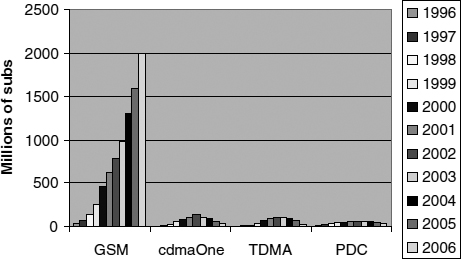1.1 Wireless World Picture
Wireless cellular communication is certainly one of the major evolutions provided to the telecommunication world, experiencing an exponential growth from the early 1990s.
Wireless communication systems started to emerge in the mid-1980s, first based on so-called 1G (first-generation) analogue technologies like AMPS (Advanced Mobile Phone System) in the United States or NMT (Nordic Mobile Telephone) in Northern Europe. Those systems have evolved to 2G (second-generation) digital radio – providing robustness and better spectral efficiency – and, ultimately, to 3G, so as to offer global mobility and improved end-user experience over a wide range of services.
The unprecedented success of wireless communication has multiple business repercussions, by developing the potential for voice traffic and added-value services like Instant text and Voice Messaging, Multimedia Messaging (MMS), high-value content delivery or streaming, location-based services, etc.
As of mid-2006, there were:
- 2.3 billion mobile subscribers worldwide.
- 1.8 billion GSM mobile subscribers – GSM represented a 78% market share of cellular subscribers.

Figure 1.1 Evolution of 2G technologies.
Figure 1.1 describes the evolution of the main 2G technologies during the past few years:
- GSM (Global System for Mobile communications), originated from Europe and worldwide deployed.
- cdmaOne, corresponding ...
Get Evolved Packet System (EPS): The LTE and SAE Evolution of 3G UMTS now with the O’Reilly learning platform.
O’Reilly members experience books, live events, courses curated by job role, and more from O’Reilly and nearly 200 top publishers.

